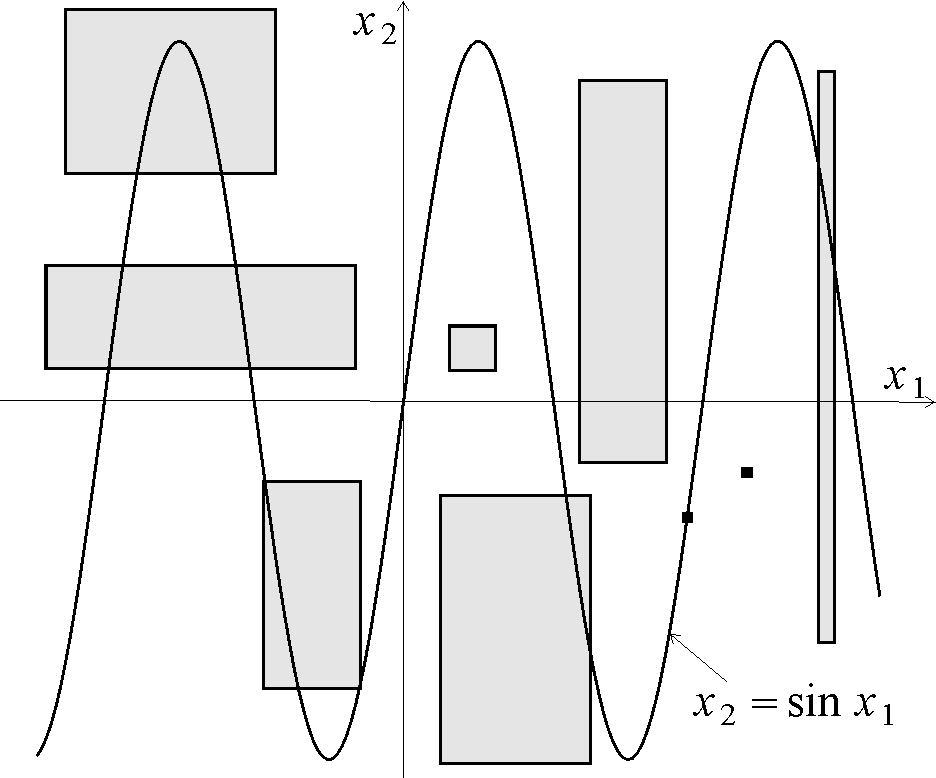Interval Propagation on:
[Wikipedia]
[Google]
[Amazon]
In

 For other constraints, a specific algorithm for implementing the atomic contractor should be written. An illustration is the atomic contractor associated to the equation
:
is provided by Figures 1 and 2.
For other constraints, a specific algorithm for implementing the atomic contractor should be written. An illustration is the atomic contractor associated to the equation
:
is provided by Figures 1 and 2.
 Assume that from different measurements, we know that
:
:
:
:
:
:
:
From the circuit, we have the following equations
:
:
:
:
After performing the interval propagation, we get
:
:
:
:
:
:
:
Assume that from different measurements, we know that
:
:
:
:
:
:
:
From the circuit, we have the following equations
:
:
:
:
After performing the interval propagation, we get
:
:
:
:
:
:
:
numerical mathematics
Numerical analysis is the study of algorithms that use numerical approximation (as opposed to symbolic manipulations) for the problems of mathematical analysis (as distinguished from discrete mathematics). It is the study of numerical methods th ...
, interval propagation or interval constraint propagation is the problem of contracting interval domains associated to variables of R without removing any value that is consistent with a set of constraints (i.e., equations or inequalities). It can be used to propagate uncertainties in the situation where errors are represented by intervals. Interval propagation considers an estimation problem as a constraint satisfaction In artificial intelligence and operations research, constraint satisfaction is the process of finding a solution through
a set of constraints that impose conditions that the variables must satisfy. A solution is therefore an assignment of value ...
problem.
Atomic contractors
A contractor associated to an equation involving the variables ''x''1,...,''x''''n'' is an operator which contracts the intervals 'x''1..., 'x''''n''(that are supposed to enclose the ''x''''i'''s) without removing any value for the variables that is consistent with the equation. A contractor is said to be ''atomic'' if it is not built as a composition of other contractors. The main theory that is used to build atomic contractors are based on interval analysis. Example. Consider for instance the equation : which involves the three variables ''x''1,''x''2 and ''x''3. The associated contractor is given by the following statements : : : For instance, if : : : the contractor performs the following calculus : : :
 For other constraints, a specific algorithm for implementing the atomic contractor should be written. An illustration is the atomic contractor associated to the equation
:
is provided by Figures 1 and 2.
For other constraints, a specific algorithm for implementing the atomic contractor should be written. An illustration is the atomic contractor associated to the equation
:
is provided by Figures 1 and 2.
Decomposition
For more complex constraints, a decomposition into atomic constraints (i.e., constraints for which an atomic contractor exists) should be performed. Consider for instance the constraint : could be decomposed into : : : The interval domains that should be associated to the new intermediate variables are : : :Propagation
The principle of the interval propagation is to call all available atomic contractors until no more contraction could be observed. As a result of the Knaster-Tarski theorem, the procedure always converges to intervals which enclose all feasible values for the variables. A formalization of the interval propagation can be made thanks to the contractor algebra. Interval propagation converges quickly to the result and can deal with problems involving several hundred of variables.Example
Consider the electronic circuit of Figure 3. Assume that from different measurements, we know that
:
:
:
:
:
:
:
From the circuit, we have the following equations
:
:
:
:
After performing the interval propagation, we get
:
:
:
:
:
:
:
Assume that from different measurements, we know that
:
:
:
:
:
:
:
From the circuit, we have the following equations
:
:
:
:
After performing the interval propagation, we get
:
:
:
:
:
:
:
References
{{Reflist, 2 Algebra of random variables Numerical analysis Statistical approximations